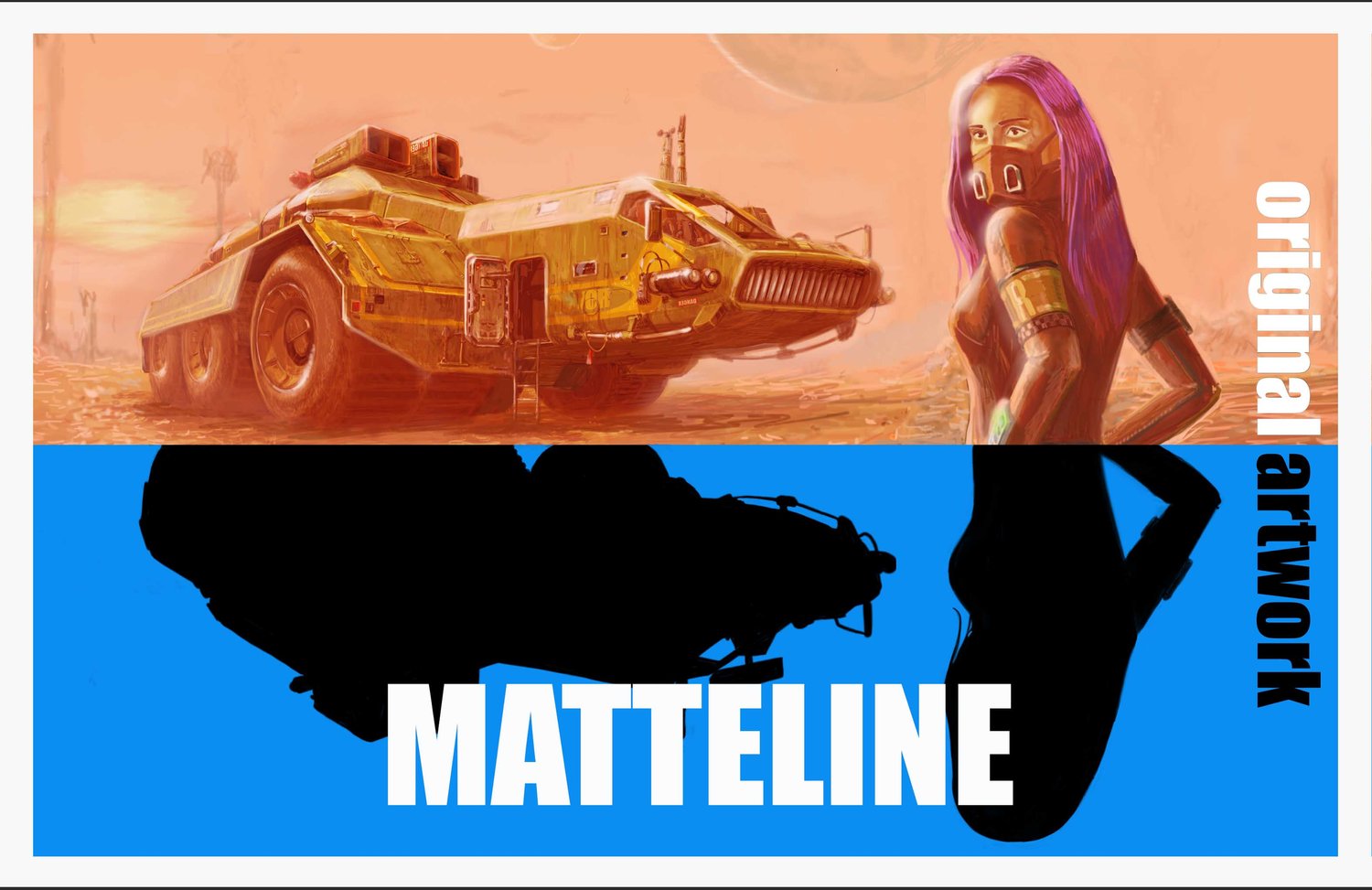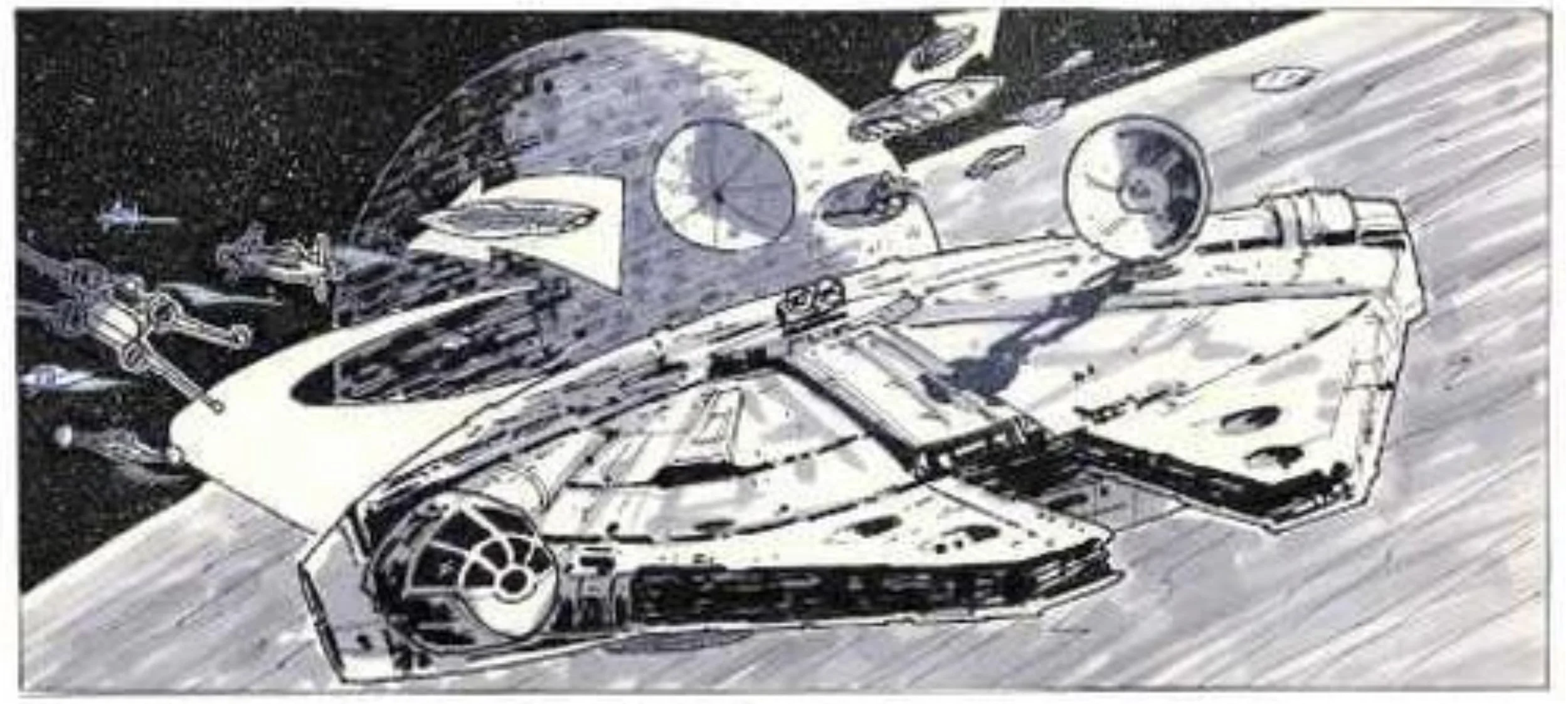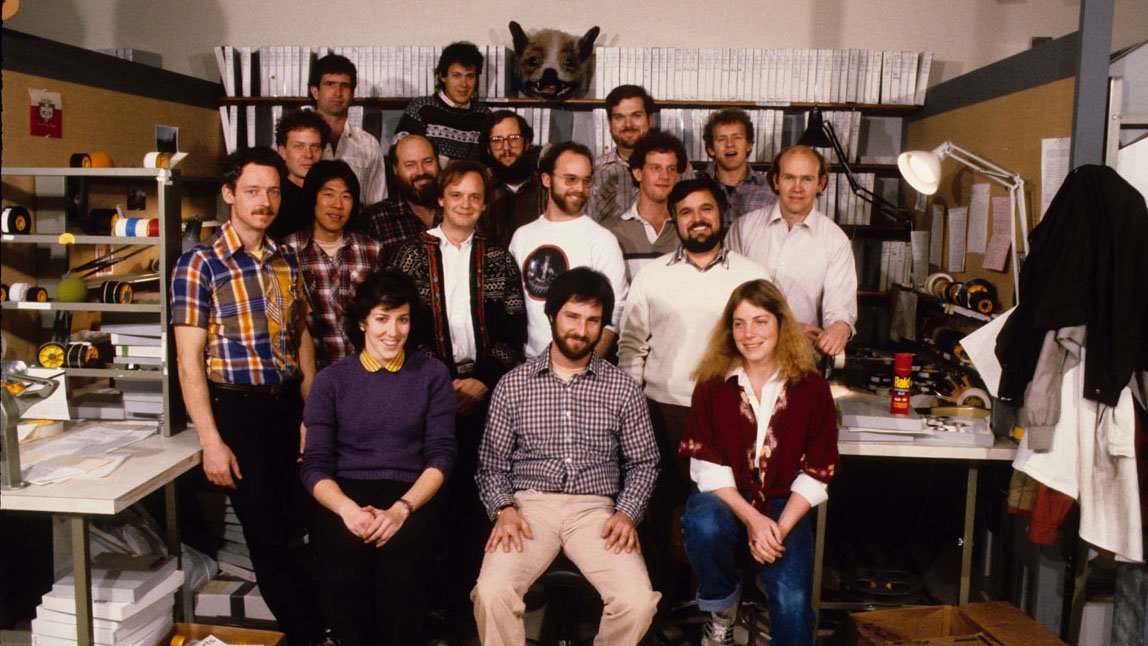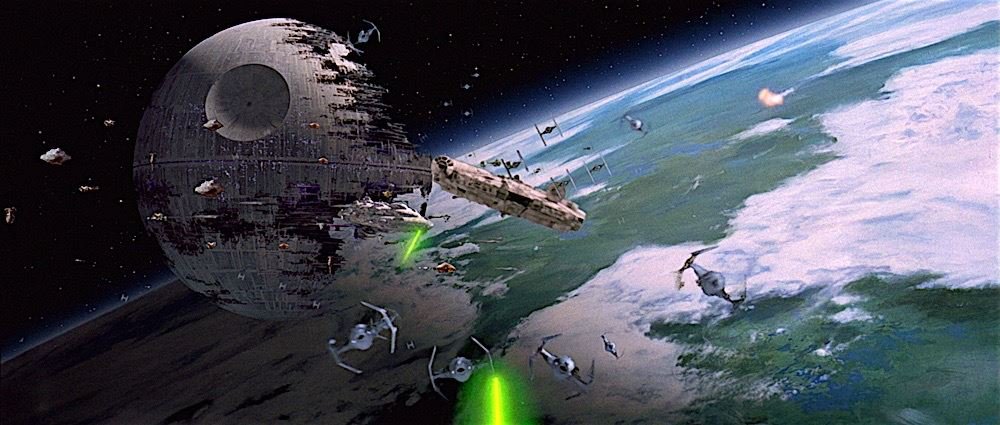The SPACE BATTLE from Return of the Jedi
February 2023
Matthew Teevan
I am a big fan of the movie ‘Return of the Jedi (aka Star Wars Episode VI). I saw it when it was originally released in 1983 and It made a huge impression on me. ‘Star Wars’ was a terrific film and a tremendous achievement; greater than the sum of its parts. ‘The Empire Strikes Back’ is a masterpiece. There is a consensus that ‘Jedi’ is a disappointment, but for me back them I was thrilled as it was brimming with tons of great scenes and a worthy conclusion to the trilogy. 40 years later I still consider it an Incredible film.
I really love the action set-pieces. There is so much in one film: The Speeder Bike chase, the attack on the Death Star, the fight with the Rancor monster, the Endor Forest battle with the AT-STs and more!
At the time I first saw it I was getting really interested in movie-making and in particular how special effects were done. The period from the late 1970s to mid 1980s was an incredible period of imagination, technical virtuosity and craftsmanship, New techniques were being developed and honed for every movie. Since ‘Star Wars’ visual effects had progressed in leaps and bounds. Star Wars to Empire was a giant leap, and since that film ILM developed optical compositing to a fine art and developed new techniques such as Go-Motion (developed for ‘Dragonslayer’) to bring creatures and machines to life like never before. ‘Return of the Jedi’ was able to benefit from all of this progress, and there was no new technology that needed to be developed for the film. By and large all of the energy and resources could be put into the shots themselves. For me this film contains the best visual effects ever put on film.
I want to single out the tremendous Space Battle scenes. This for me, is the best space battle scene to date. We get to see some new ships – A-Wings and B-Wings as well as the familiar X-Wings and Y-Wings. The Empire have new TIE Interceptors which fight side by side with the familiar TIE Fighters. The Rebels have giant cruisers as well other large ships from the previous movies – Transport ships, the Blockade Runner - from the beginning of Star Wars - and the Medical Frigate seen at the end of The Empire Strikes Back’. These new ships square off with Star Destroyers, the Super Star Destroyer and an under-construction Death Star. And in the middle of it all is the Millennium Falcon! And every ship has its moment.
The ships fly around in a seemingly chaotic manner, trying to shoot each other down. They dive down into view, and bank or climb away to avoid streams of laser fire. Some ships are destroyed mid manoeuvrer. The camera seemingly picks out individual dog-fights or skirmishes. Point of view shots – a hallmark of the Star Wars movies – are used a lot as we fly through the battle area and we see glimpses of action taking place above us, below us and to either side of us. It is thrilling stuff. And a real wow on the big screen! We the audience experience the chaos and intensity of what is going on, but we are never confused. We feel like we are there, or at the very least watching footage of a real battle. It feels natural and real.
But this is all 100% fabricated. Everything has been meticulously choreographed. Every spaceship, every explosion, every laser blast has all been put there precisely. Nothing we see is accidental. Think about it. It is all intentional, yet feels completely natural and spontaneous. It is completely believable.
I have always had the utmost admiration for the work of this period, and all of the time and effort that must have gone into these scenes As I understand it everything was storyboarded out as individual panels. Each spaceship was then photographed individually using the motion control / blue-screen techniques developed for ‘Star Wars’ and perfected on ‘The Empire Strikes Back’ and ‘Star Trek II – The Wrath of Khan’. The ship models were mounted on a static armature, or post, positioned between the camera and a Blue Screen. Often the armature of ‘post’ would have the same blue hue. The computer-controlled Motion Control camera would then travel along a track, with the appropriate pitching, rotating and panning to simulate the motion of the ship. The camera moves: the ship remains motionless. Everything in the camera’s view that is blue can be made to disappear during a series of special printing techniques. This leaves a piece of film with only the spaceship on it and it appears to be flying. This is the process for every spaceship. The Motion Control camera allows the same motion to be repeated, allowing each ship - shot separately - to look like it was shot with the same camera. (There is more on this process in my ‘Why the special visual effects in Star Wars are so special’ blog page). The spaceships – often grey or white – would be prone to particularly prone to pick up ambient light, so were often lit with a ‘yellow’ hue to help the blue-screen matte extraction. This yellow would then be corrected or ‘removed’ during final optical compositing. Every spaceship model was choreographed and photographed individually this way. Many of the models were different scales to one another. Distant ships were sometimes photographs of the models that were cut and mounted on panes of glass. Laser fire was hand animated on top of the assembled composite, literally drawing streams of lasers from one ship to another. The explosions were usually drawn from a vast library of pyrotechnics which had shot against black to provide excellent mattes. These would be carefully lined up to the ship in question replacing the ship element in synch with the laser fire. All very complicated and time consuming. No computers, or pre-viz, or graphical animation programmes. All mechanical cameras and rigs, physical hand made models and hand drawn animation. Simply incredible.
Original Joe Johnston Storyboard Final composite VFX supervised by Ken Ralston
So that is practically speaking, basically how each shot was done. But how were the shots actually created? Typically with visual effects there is a background plate that is shot (such as the Death Star trench in ‘Star Wars’) and the spaceships are then lit and photographed at the necessary angles to match the background. But with this scene, where the camera is constantly moving and there really is no background… just some stars. Or occasionally a planet or the Death Star… but this does not seem like enough to build the shot around. So I imagine they must have identified a key ship, or ships. to shoot first and did a rough composite to make sure they were working and then shoot more ships adding to that basic starting point. But I would love to know for sure. A bit mind boggling.
I recently did a painting depicting a moment from this space battle and my appreciation went up. Way up! I based the composition on an actual shot from the film, where we follow the Falcon as it chases a TIE Interceptor that ducks down under the Medical Frigate. I also included the ‘burning Tie Fighter’ that features in a later shot. I found it difficult just trying to lay out the single frame composition with all the spaceships ‘posed’ to looks like they are fighting and chasing each other. Getting the lighting to a point where each ship was readable was tricky. As well as maintaining the correct scale and conveying the distance of ships being hundreds of yards, or miles apart in the vacuum of space!. It was really quite challenging. Now, to some small degree. trying to capture a scene like this in a single frame is its own challenge, but it really made me think about what the ILM team accomplished 40 years ago. I had everything in front of me in one image in an editable format. ‘Jedi’ was made in the 1980s, when the motion control cameras were slow-moving and optical compositing was a labour intensive time consuming process. If you take a step back and think about these shots, you really scratch your head... How did they actually do this and make it all work. In his review at the time, Roger Ebert enthused that it looked like they took a film crew into outer space to shoot this stuff!
Everyone involved was at the top of their game. The shots where the Millennium Falcon chases a TIE interceptor as it peels off under the Medical Frigate is an absolute gem. You can feel the G-forces as we follow the action. It all looks right. You accept it all. And I think this suggests to the viewer that maybe it was not that difficult to accomplish. You don’t question it. There is a looseness to the camera work that I think really is a big part makes it all work so well. The success of this sequence owes a lot to the ‘The Asteroid Field’ sequence in ‘The Empire Strikes Back’ which is a fantastic jaw dropping piece of filmmaking! Many of the core techniques were perfected there and to this day that sequence is phenomenal. ‘The Asteroid Field’ feels like a ballet – it is perfect, as if performed by professional dancers. The Space Battle feels a bit more like a dance at a rock-n-roll concert. It looks and feels so natural. It looks easy. Cutting between the ‘aerial footage’ exterior shots and the cockpit shots all cuts together perfectly. Everything you see out of the cockpit windows is fabricated separately too. You watch it, and accept it. It all looks very natural and easy.
There was an excellent documentary made in the 1980s which aired as an episode of the BBC TV Series Horizon as ‘How to Film The Impossible’ which incilded coverage of he Jedi space battle as well as the Mine Car Chase in ‘Indiana Jones and the Temple of Doom’. In the programme they talk about the most technically complex optical composite ever created - in terms of the number of individual elements - and seeing the boxes containing the tiny rolls of film - probably no more than 60 or 70 frames in length, each one representing one spaceship. It is really hard to reconcile this with the spectacular finished shot!
Optical Photography Supervisor Bruce Nicholson and the ILM Optical Dept. George Lucas and an array of his spaceships.
Of course there were thousands of dollars worth of precision equipment involved as well as some enormously talented technicians and artists. The Motion Control cameras, the (high resolution) 8 perf ‘Vistavision’ film itself’ and the Optical Printers that were state of the art at the time. But even so, it is magical. You look at this behind the scenes stuff and you just shake your head… how did this really work and produces images that look real? Of course as with all films and VFX there are some minor technical errors – in some shots some of the elements appear to slide against one another, and there are some inevitable matte-lines. The garbage mattes – static squares that jump across the screen following the ships through the frame - were common with this type of blue screen work and were not nearly as noticeable in the cinema as they are, or were, on TV and video. But nothing that takes you out of the moment. Interestingly when the ‘special editions’ of the films were made in the late 1990s, there were no creative changes to this sequence. Just some minor paint touch up to get rid of some matte-line edges of the ships.
Of course massive credit must go to Visual Effects Supervisor KEN RALSTON and Visual Effects Art Director JOE JOHNSTON for conceiving and putting together this giant sequence. And making it both overwhelming and coherent. It is totally believable.
Ken Ralston, Motion Control camera and the Blockade Runner. Joe Johnston at ILM
The film received a Special Achievement Accademy Award for Outstanding Visual Effects (Richard Edlund, Dennis Muren, Ken Ralston and Phil Tippet were the winners). and for me this film stands as the pinacle of pre-digital visual effects. The Accademy Awards are filled with odd choices and glaring oversights, but in this case the entire VFX team did a remarkable job and were justly awarded.
There is a fun piece of trivia that Ralston filmed one of his tennis shoes as one of the ships in the space battle. 40 years later, and probably a million or more video freeze-frames later, nobody has been able to identify this ‘unique spacecraft’. This was of course the point. With so much going on, it was not going to be recognized. It was just part of the scope of this massive event being captured on film. Such is the mastery of the craft that an intentional mistake can be designed to go by unnoticed.
In this day and age of computer graphics, digital composting, pre-visualised scenes, digital editing and so much more, we are used to seeing anything and everything and it looks real. (This work is exhaustive and needs very talented people to pull it off - it is not ‘just cg’). The climax of ‘Rogue One’ (2016) and the opening of ‘Revenge of the Sith’ (2005) feature massive space battles and are outstanding. But years later, the ‘Jedi Space Battle’ is still the gold standard. The one to beat. The effects in those films are remarkable, but simultaneously stand on the shoulders and walk in the shadow of this absolute gem of spectacular action. It is a truly incredible achievement of visual effects filmmaking.
‘Why the Special Visual Effects in Star Wars are so Special’:
what makes the special effects in STAR WARS so special
My painting of the ‘Return of te Jedi’ space battle in the Classic Sci-Fi gallery.
SF - Return of the Jedi Space Battle









